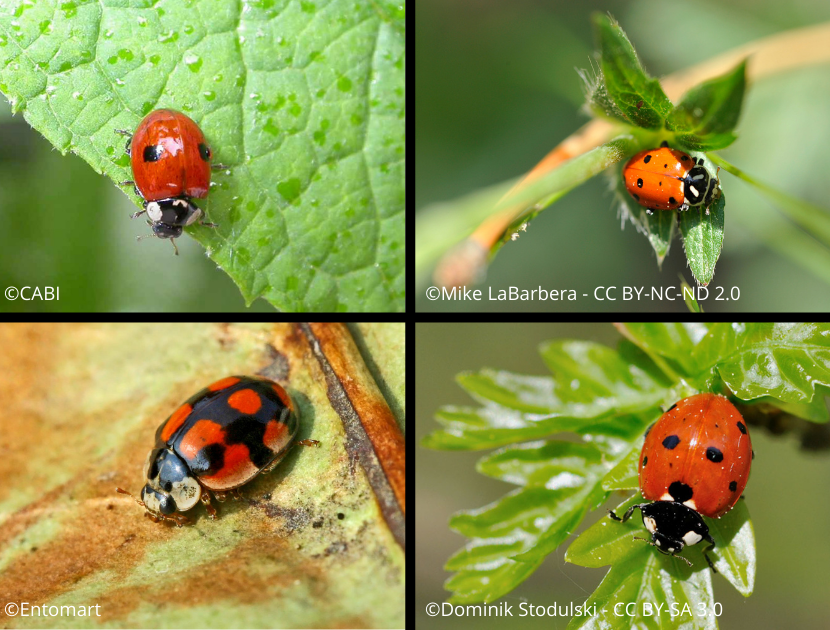
The invasive harlequin ladybird (Harmonia axyridis) was first used as a biocontrol agent against aphids in North America in 1916. Since then, it was first found in the wild in 1988. It has now spread rapidly and invaded most of North America and Europe. As a result, it is now spreading to other regions such as South America and South Africa.
In most regions where the invasive harlequin ladybirds is present, numbers have greatly increased. It has quickly become the most widespread ladybird in a wide range of habitats. The invasion is a concern for the populations of native ladybirds and other insects that also feed on aphids.

A recent example of this predation was shown by a CABI-led 11-year study, where the invasive harlequin ladybird was seen to cause severe decline of the two-spotted ladybird (Adalia bipunctata) on broadleaved trees and shrubs in northern Switzerland. First confirmed in the country in 2004, it quickly dominated and represented 60-80% of all specimens collected in broadleaved hedges.
The CABI study found that, due to its predatory and competitive abilities, harlequin ladybirds may affect many native species. In particular, native ladybirds may suffer from competition for resources and intra-guild predation on larvae and eggs.
The harlequin ladybird can also cause additional problems, such as tainting wine when it ends up being crushed with the grapes, and damaging orchard crops by feeding on soft fruit when aphids become scarce in the late summer and autumn. It is also considered a human nuisance because it amasses in buildings looking for overwintering sites in the autumn.
How do I identify the invasive harlequin ladybird?

They vary widely in colour and pattern, but adults are 5–8 mm long and 4–6.5 mm wide. The head can be black, yellow or black with yellow markings, while the pronotum (directly behind the head) is creamish-yellow with black markings. The elytra (forewing of a beetle) colour may be orange, red or black. Although other forms with bars or stripes, or large patches of pale colour on a black may occur, the following are the most common:
| Form | Elytra colour | Pattern |
| f. succinea complex | Orange or red | 0- 21 black spots |
| f. axyridis | Orange or red | Grid-like black pattern |
| f. conspicua | Black or melanic | Two large orange or red spots |
| f. spectabilis | Black or melanic | Four large orange or red spots |
There is also a geographic difference, with f. conspicua and f. spectabilis more common in parts of Asia, but rare in the USA. In the USA and UK, f.succinea complex are more prevalent.
Where will I find them?
Favoured habitats of the invasive harlequin ladybird include orchards, forest stands and old-field vegetation, harlequin ladybirds are also able to spread to a wide range of habitats including agricultural ecosystems, along river banks, urban areas and wetlands.
What should I do if they infest my home?
The invasion of harlequin ladybirds into households can be limited by preventing the beetles from entering the building, such as by sealing holes or covering them with fine mesh to restrict entry. They can also be removed from unwanted locations manually, for example, using a vacuum cleaner with a mesh covering (such as a stocking) placed over the end of the hose to prevent the ladybirds from moving inside the vacuum drum.
If your home is infested with harlequin ladybirds, take care not to cause too much disturbance, as this can result in excessive reflex bleeding, which can cause damage (staining) to soft furnishings. Repellents such as camphor and menthol can be applied to entry points such as windows, doors, eaves and foundations, but insecticide use inside buildings is usually not advised.
Similar species

Harlequin ladybirds can easily be confused with other ladybird species, such as the two-spotted lady beetle (Adalia bipunctata), or ten-spot ladybird (Adalia decempunctata), though harlequin ladybirds are much larger beetles. They are also similar to the convergent lady beetle (Hippodamia convergens).
Further information
Invasive harlequin ladybird causes severe decline of two-spotted ladybird, new long-term study shows
ISC datasheet – Harmonia axyridis (harlequin ladybird)
Discover more invasive insects and other invasive species on the Invasive Species Compendium.
Related News & Blogs
Invasive weeds in America’s Western states: restoring balance using biological control
In many of America’s Western states, invasive weeds such as houndstongue (Cynoglossum officinale), Russian knapweed (Rhaponticum repens), yellow and Dalmatian toadflax (Linaria vulgaris and Linaria dalmatica), oxeye daisy (Leucanthemum vulgare), and hoary cress (Lepidium draba) are serious problems. However, research shows that biological control, as part of an integrated weed management strategy, offers the potential for a cost effective and efficient way of reducing invasive plant species to levels below acceptable damage thresholds.
10 August 2020
